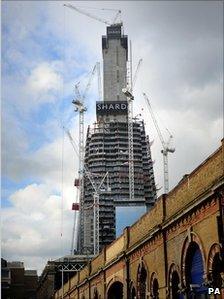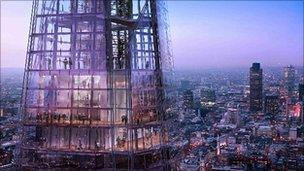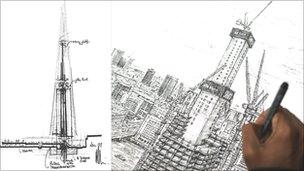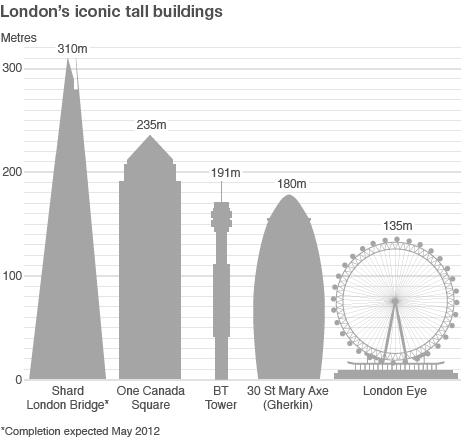Shard London Bridge skyscraper splinters opinion
- Published

Shard London Bridge's shell is scheduled to be completed by 2012
It began as a sketch on the back of a napkin in a Berlin restaurant in 2000. Ten years on, Shard London Bridge is the tallest building in the UK, at more than 235m (771ft).
Designed by Italian architect Renzo Piano, the south London skyscraper is planned to rise to 87 storeys, 310m (1,016ft) by 2012, becoming the tallest building in the European Union.
Mr Piano has a clear vision of the positive impact he thinks the tower will have on the city.
"The building will be atmospheric. It will play with the city. It will be a symbol of lightness," he said.
But the skyscraper, better known as the Shard of Glass, also has its critics.
"I would have liked to see something more materially interesting and elegant," said Philippa Grantham, 31, who has watched the tower rise on the capital's skyline each day on her commute into London Bridge station.
"In my opinion, a tower doesn't have a particular front or a back but this building certainly has a back side and it's fairly crude."
'Vertical city'
Mr Piano said the tower was not meant to dominate the skyline and its sophisticated use of glazing would reflect light and the changing patterns of the sky.
"After a shower it will be blue. In the evening it will become warmer and more red," he said.

Shard London Bridge will have a viewing gallery on its 72nd floor
The building was designed to be a "vertical city that has many functions," he added.
"It will be living 24 hours a day and intensify city life."
The Shard will have office space at its base and, higher up the building, will contain a hotel, apartments, a viewing gallery and spire at the top.
In 2003, following a £10m public inquiry, the Shard was approved by then Deputy PM John Prescott.
But English Heritage said it was disappointed with the outcome and the building was "inappropriate".
Key objections it raised included concerns over the impact on views of St Paul's Cathedral from Parliament Hill.
But the Shard's property developer James Sellar said that its 244m (800ft) viewing gallery "will open up the views of places like St Paul's that have never been seen".
Local campaigners Bermondsey Village Action Group (BVAG) fear the Shard will create a "domino effect" with more tall buildings being approved, forming a "wall of steel and glass".
Last week, a 31-storey tower - The Quill - was approved by Southwark council, which will stand within metres of the Shard.
"The Shard is the umbrella under which the proposed high-rise buildings in the area are seeking to take shelter," said Russell Gray, from BVAG.
"Secrecy is the name of the game with the Shard."
'High benchmark'
But Mr Sellar said: "The design philosophy is about transparency rather than opaqueness."
"We've set a pretty high benchmark for the regeneration of the area."
Mr Piano said he did not want the Shard to create an influx of tall buildings in the capital.
"By making one tall building, you can't assume that more tall buildings in the area are good."

The Shard was conceived on the back of a napkin at a Berlin restaurant in 2000
But he said the Shard will make the area "a more humanised place".
And through the regeneration of London Bridge station, as part of the Shard development, "it will be a better place to travel through", he said.
The tower's supporters believe the building will be a pivotal moment for south London.
"It is a landmark building and is a flag for the regeneration," Mr Sellar said.
So will the Shard become an iconic landmark to rival New York's Empire State Building or Paris' Eiffel Tower?
"You can't be narcissistic and say I'm going to make the iconic building," said Mr Piano.
"But it may become iconic in time."
The shell of the building is due to be completed by May 2012,
And the Olympics planned for that year should prove an opportunity to beam the Shard's image around the world.
"With more than a billion people looking at London for the Olympics, its a great way to have the building presented and the capital's innovation celebrated," said Mr Sellar.

- Published3 December 2010